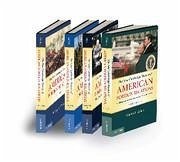William Earl Weeks, Walter Lafeber, Akira Iriye, Warren I Cohen
The New Cambridge History of American Foreign Relations 4 Volume Set
William Earl Weeks, Walter Lafeber, Akira Iriye, Warren I Cohen
The New Cambridge History of American Foreign Relations 4 Volume Set
- Broschiertes Buch
- Merkliste
- Auf die Merkliste
- Bewerten Bewerten
- Teilen
- Produkt teilen
- Produkterinnerung
- Produkterinnerung
These four volumes have served as the definitive source for the topic, from the colonial period to the Cold War.
Andere Kunden interessierten sich auch für
![The Cambridge History of British Foreign Policy, 1783-1919 3 Volume Set The Cambridge History of British Foreign Policy, 1783-1919 3 Volume Set]() The Cambridge History of British Foreign Policy, 1783-1919 3 Volume Set224,99 €
The Cambridge History of British Foreign Policy, 1783-1919 3 Volume Set224,99 €![The Cambridge History of the Age of Atlantic Revolutions 3 Hardback Book Set The Cambridge History of the Age of Atlantic Revolutions 3 Hardback Book Set]() The Cambridge History of the Age of Atlantic Revolutions 3 Hardback Book Set388,99 €
The Cambridge History of the Age of Atlantic Revolutions 3 Hardback Book Set388,99 €![The Cambridge History of Nationhood and Nationalism 2 Volume Hardback Set The Cambridge History of Nationhood and Nationalism 2 Volume Hardback Set]() The Cambridge History of Nationhood and Nationalism 2 Volume Hardback Set255,99 €
The Cambridge History of Nationhood and Nationalism 2 Volume Hardback Set255,99 €![The Cambridge History of the Napoleonic Wars 3 Volume Hardback Set The Cambridge History of the Napoleonic Wars 3 Volume Hardback Set]() The Cambridge History of the Napoleonic Wars 3 Volume Hardback Set399,99 €
The Cambridge History of the Napoleonic Wars 3 Volume Hardback Set399,99 €![The Cambridge History of Medieval Music 2 Volume Hardback Set The Cambridge History of Medieval Music 2 Volume Hardback Set]() The Cambridge History of Medieval Music 2 Volume Hardback Set285,99 €
The Cambridge History of Medieval Music 2 Volume Hardback Set285,99 €![The Cambridge History of the European Union 2 Volume Hardback Set The Cambridge History of the European Union 2 Volume Hardback Set]() The Cambridge History of the European Union 2 Volume Hardback Set253,99 €
The Cambridge History of the European Union 2 Volume Hardback Set253,99 €![The Cambridge Global History of Fashion 2 Volume Hardback Set The Cambridge Global History of Fashion 2 Volume Hardback Set]() The Cambridge Global History of Fashion 2 Volume Hardback Set253,99 €
The Cambridge Global History of Fashion 2 Volume Hardback Set253,99 €-
-
-
These four volumes have served as the definitive source for the topic, from the colonial period to the Cold War.
Produktdetails
- Produktdetails
- Verlag: Cambridge University Press
- Seitenzahl: 1264
- Erscheinungstermin: 28. Juni 2013
- Englisch
- Abmessung: 247mm x 174mm x 95mm
- Gewicht: 2334g
- ISBN-13: 9781107031838
- ISBN-10: 1107031834
- Artikelnr.: 38602505
- Herstellerkennzeichnung
- Libri GmbH
- Europaallee 1
- 36244 Bad Hersfeld
- gpsr@libri.de
- Verlag: Cambridge University Press
- Seitenzahl: 1264
- Erscheinungstermin: 28. Juni 2013
- Englisch
- Abmessung: 247mm x 174mm x 95mm
- Gewicht: 2334g
- ISBN-13: 9781107031838
- ISBN-10: 1107031834
- Artikelnr.: 38602505
- Herstellerkennzeichnung
- Libri GmbH
- Europaallee 1
- 36244 Bad Hersfeld
- gpsr@libri.de
William Earl Weeks is Lecturer in History at San Diego State University. He is the author of John Quincy Adams and American Global Empire (1992) and Building the Continental Empire, 1815-1861, and co-editor of American Foreign Relations since 1600: A Guide to the Literature (2003).
Volume 1. Dimensions of the Early American Empire, 1754-1865: 1. Origins of the American empire and union
2. A perilous union, 1783-96
3. The 'Empire of Liberty' on land and sea
4. Towards hemispheric superiority
5. Freedom's empire
6. Expansionist vistas: Canada, Oregon, California, and Texas
7. Bulling Britain, conquering Mexico, claiming the canal
8. Disunion
9. The imperial crisis, 1861-5. Volume 2. The American Search for Opportunity, 1865-1913: 1. Springboards and strategies
2. The second industrial revolution at home and abroad
3. Race for empire
4. 'America will take this continent in hand along'
5. Crossing the oceans
6. 1893-6: chaos and crises
7. The empire of 1898 - and beyond
8. Pacific empire - and upheaval
9. Theodore Roosevelt: conservative as revolutionary
10. William Howard Taft and the age of revolution
Conclusion: 11. The 1865-1913 era restated. Volume 3. The Globalizing of America, 1913-1945: 1. The age of European domination
2. The Great War and American neutrality
3. The United States at war
4. The Versailles peace
5. The 1920s: the security aspect
6. The 1920s: the economic aspect
7. The 1920s: the cultural aspect
8. The collapse of international order
9. Totalitarianism and the survival of democracy
10. The emergence of geopolitics
11. The road to Pearl Harbor
12. The global conflict. Volume 4. Challenges to American Primacy, 1945 to the Present: Part I. The Cold War: 1. At war's end: visions of a new world order
2. Origins of the Cold War
3. The Korean War and its consequences
4. New leaders and new arenas in the Cold War
5. Crisis revolution
6. America's longest war
7. The rise and fall of détente
8. In God's country
9. America and the world, 1945-91
Part II. After the Cold War: 10. The new world order
11. The 'war' against terrorism.
2. A perilous union, 1783-96
3. The 'Empire of Liberty' on land and sea
4. Towards hemispheric superiority
5. Freedom's empire
6. Expansionist vistas: Canada, Oregon, California, and Texas
7. Bulling Britain, conquering Mexico, claiming the canal
8. Disunion
9. The imperial crisis, 1861-5. Volume 2. The American Search for Opportunity, 1865-1913: 1. Springboards and strategies
2. The second industrial revolution at home and abroad
3. Race for empire
4. 'America will take this continent in hand along'
5. Crossing the oceans
6. 1893-6: chaos and crises
7. The empire of 1898 - and beyond
8. Pacific empire - and upheaval
9. Theodore Roosevelt: conservative as revolutionary
10. William Howard Taft and the age of revolution
Conclusion: 11. The 1865-1913 era restated. Volume 3. The Globalizing of America, 1913-1945: 1. The age of European domination
2. The Great War and American neutrality
3. The United States at war
4. The Versailles peace
5. The 1920s: the security aspect
6. The 1920s: the economic aspect
7. The 1920s: the cultural aspect
8. The collapse of international order
9. Totalitarianism and the survival of democracy
10. The emergence of geopolitics
11. The road to Pearl Harbor
12. The global conflict. Volume 4. Challenges to American Primacy, 1945 to the Present: Part I. The Cold War: 1. At war's end: visions of a new world order
2. Origins of the Cold War
3. The Korean War and its consequences
4. New leaders and new arenas in the Cold War
5. Crisis revolution
6. America's longest war
7. The rise and fall of détente
8. In God's country
9. America and the world, 1945-91
Part II. After the Cold War: 10. The new world order
11. The 'war' against terrorism.
Volume 1. Dimensions of the Early American Empire, 1754-1865: 1. Origins of the American empire and union
2. A perilous union, 1783-96
3. The 'Empire of Liberty' on land and sea
4. Towards hemispheric superiority
5. Freedom's empire
6. Expansionist vistas: Canada, Oregon, California, and Texas
7. Bulling Britain, conquering Mexico, claiming the canal
8. Disunion
9. The imperial crisis, 1861-5. Volume 2. The American Search for Opportunity, 1865-1913: 1. Springboards and strategies
2. The second industrial revolution at home and abroad
3. Race for empire
4. 'America will take this continent in hand along'
5. Crossing the oceans
6. 1893-6: chaos and crises
7. The empire of 1898 - and beyond
8. Pacific empire - and upheaval
9. Theodore Roosevelt: conservative as revolutionary
10. William Howard Taft and the age of revolution
Conclusion: 11. The 1865-1913 era restated. Volume 3. The Globalizing of America, 1913-1945: 1. The age of European domination
2. The Great War and American neutrality
3. The United States at war
4. The Versailles peace
5. The 1920s: the security aspect
6. The 1920s: the economic aspect
7. The 1920s: the cultural aspect
8. The collapse of international order
9. Totalitarianism and the survival of democracy
10. The emergence of geopolitics
11. The road to Pearl Harbor
12. The global conflict. Volume 4. Challenges to American Primacy, 1945 to the Present: Part I. The Cold War: 1. At war's end: visions of a new world order
2. Origins of the Cold War
3. The Korean War and its consequences
4. New leaders and new arenas in the Cold War
5. Crisis revolution
6. America's longest war
7. The rise and fall of détente
8. In God's country
9. America and the world, 1945-91
Part II. After the Cold War: 10. The new world order
11. The 'war' against terrorism.
2. A perilous union, 1783-96
3. The 'Empire of Liberty' on land and sea
4. Towards hemispheric superiority
5. Freedom's empire
6. Expansionist vistas: Canada, Oregon, California, and Texas
7. Bulling Britain, conquering Mexico, claiming the canal
8. Disunion
9. The imperial crisis, 1861-5. Volume 2. The American Search for Opportunity, 1865-1913: 1. Springboards and strategies
2. The second industrial revolution at home and abroad
3. Race for empire
4. 'America will take this continent in hand along'
5. Crossing the oceans
6. 1893-6: chaos and crises
7. The empire of 1898 - and beyond
8. Pacific empire - and upheaval
9. Theodore Roosevelt: conservative as revolutionary
10. William Howard Taft and the age of revolution
Conclusion: 11. The 1865-1913 era restated. Volume 3. The Globalizing of America, 1913-1945: 1. The age of European domination
2. The Great War and American neutrality
3. The United States at war
4. The Versailles peace
5. The 1920s: the security aspect
6. The 1920s: the economic aspect
7. The 1920s: the cultural aspect
8. The collapse of international order
9. Totalitarianism and the survival of democracy
10. The emergence of geopolitics
11. The road to Pearl Harbor
12. The global conflict. Volume 4. Challenges to American Primacy, 1945 to the Present: Part I. The Cold War: 1. At war's end: visions of a new world order
2. Origins of the Cold War
3. The Korean War and its consequences
4. New leaders and new arenas in the Cold War
5. Crisis revolution
6. America's longest war
7. The rise and fall of détente
8. In God's country
9. America and the world, 1945-91
Part II. After the Cold War: 10. The new world order
11. The 'war' against terrorism.








